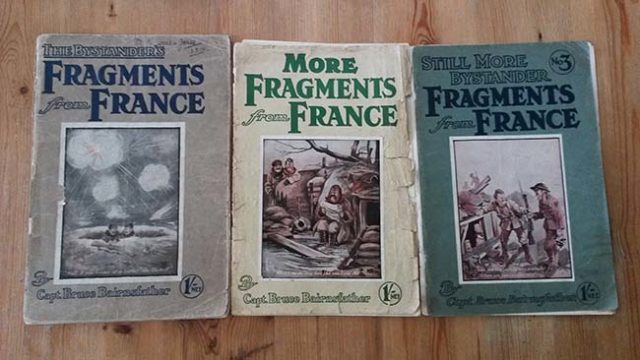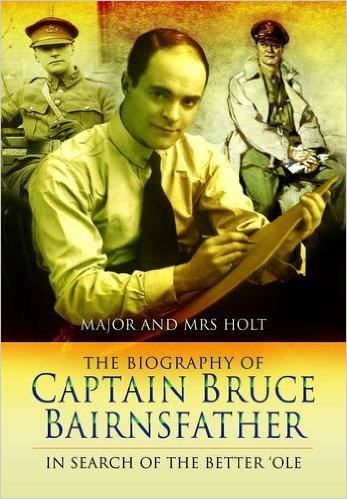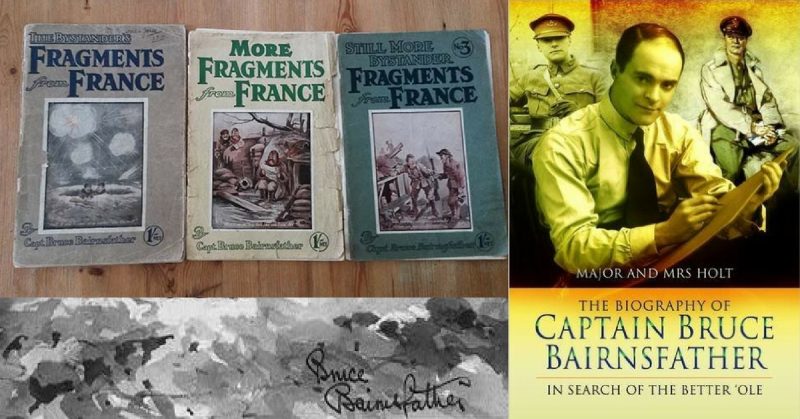I had a colleague who was deep into a mammoth project collating the histories of all the illustrators who had contributed material for one of the newspapers I work for. After some weeks of digging out odd bits of artwork for him, he suddenly produced a carrier bag and said, “You’re the only person I know who will appreciate these.” The bag contained a selection of original Great War publications, including classic Bystander compendiums of the work of the brilliant Captain Bruce Bairnsfather – the creator of Old Bill.
These days a lot of people would simply say Bruce who? But there was a time when he literally was the most famous cartoonist in the world; a veteran of the trenches who could communicate what the experience was like through the eyes of the ordinary soldier. His work was sought after by front line soldiers of many nationalities, and his popularity was not confined to the rank and file. Many officers of all ranks appreciated his humor and wanted to share in it. Staff officers, on the other hand, were the butt of his critical eye for detail and were often less enamored.
At home in Britain reaction to his work was mixed. It was the nature of a country ruled by a prejudiced and more than a little fearful minority – the establishment – where some armchair generals and a posse of oafs took umbrage with depictions of soldiers who did not conform to the chocolate-box imagery of Imperial myth. In their imagination, the humble Tommy should remain the unquestioning salt of the earth type projecting patriotic zeal and shiny uniformed perfection. The inconvenient reality of lice, trench foot, poor diet and world-weary resignation were a long way from the stuff of idealistic recruiting posters and idle drawing room chatter in the smart parts of London.
Bairnsfather was the recipient of criticism from some quarters of the elites anchored at home, and his response was to carry on regardless, safe in the knowledge his true audience were quite content. This fits with the accounts from a succession of front line soldiers who were happy to return to their clannish world on the front line because the homeland they fought for had become dislocated and alien. You read it, inevitably, in Sassoon but also in the accounts of others such as ‘Dick’ Read and Norman Collins. The separation is perpetuated today by occasional Facebook statuses declaring civilian friendships are not as meaningful as those of the military, however hubristic the claim may be.

Bairnsfather had long been an easy target for people who chose to make disdainful assumptions his undoubted talents were just ‘a bit of drawing’. He had experienced it from a young age. His sort, the comfortable middle-class; were meant to be soldiers and leaders – not silly artists. Mediocre people might take comfort in their narrow prejudice, but how he transcended all this nonsense is a measure of his brilliance.
Bairnsfather’s rise came at a time when broadcast media and influential comic books were a thing of the future. The theater, music hall and the flickery novelty of early cinema were the big draw and our hero expanded into these worlds with varying degrees of success. That he became so in demand is really quite incredible in comparison to our 4G world as missions to chronicle the French, Italian and US armies were approved by the War Office. He might have ended up feted, powerful and rich but he didn’t. He wasn’t good with money; he was a little too trusting and didn’t have a head for business. His private life was a bit of a soap opera, and it strikes me that he never truly found the contentment he deserved. Perhaps with better friends, a bit more luck and in the right time and place, he might have been a Walt Disney or someone like him. But it was not to be.
Bairnsfather was never honored in his own country. At a time when the present honors system is under such scrutiny, it is easy to see how someone like him, a fly in the establishment ointment, would be overlooked. He traveled beyond the UK to North America to find fulfillment and led a busy life there. When the Second World War broke out, his kind of humor was rejected by the powers that be in London. Some people had long memories. Our hero became a cartoonist for the United States Army Air Force where his work was appreciated. A B-17 was even named after his best-known character Old Bill in his honor.
He died in September 1959, but his legacy seems to be everywhere. Newspaper cartoonists are a clannish bunch, themselves, liking nothing more than the chance to reinterpret old masterpieces. The authors of this fine book found many examples of the kindest imitation flattering contemporary cartoons with the essence of Bruce Bairnsfather. His work permeated down to us in so many ways: through chinaware, car radiator mascots and other memorabilia. The variety is endless. Bairnsfather collectibles are much sought after and some change hands for very serious money.
His spirit transcended beyond his own iconic work into other walks of life. My parents were both London bus conductors and as a kid I remember occasional encounters with Ole Bill, the original Great War omnibus troop transport wheeled out on special occasions. My mother gave me a photo given of a man who claimed to have driven the bus on the Western Front. She was quite convinced the man was Old Bill himself. The authors of this book show us many examples of men who made similar claims, but the character was an amalgam of soldiers the artist knew in the trenches when he served with the Royal Warwicks. One of his contemporaries was a certain Major Bernard Law Montgomery while another was a chap named AA Milne. Bairnsfather’s heroes were the ordinary Tommy Atkins – men who ‘swung the lead’ seeking the least path of resistance to the easiest life from the worst of circumstances. Soldiers have been living that way since time immemorial. Bairnsfather’s trusted audience knew this to be true, and it was the foundation of his greatness.
Tonie and Valmai Holt are longstanding devotees of Bairnsfather and his vast canvas of memorabilia. They know their man and it is apparent their affection for him is immense. The story of his life is not all roses, and while the authors have no difficulty in stressing his importance to modern culture it is clear that Bairnsfather is a man who deserved much more acknowledgment for his genius. I suppose it is fair to remind ourselves that many great artists have suffered a similar fate.
This is not a new book having gone through previous incarnations, but the period of Great War centenary that was bound to bring it back to us. The biographical section is supported by a huge selection of his artwork and archive photography of the man at work and play. The latter part of the book offers a collectors catalog of Bairnsfather inspired memorabilia in addition to further examples of original work. The reissue of this book confirms the enduring charm of Old Bill and his mates. Times may have changed, but quality never fades.
That Bruce Bairnsfather was a great artist is beyond doubt. He possessed a wicked sense of humor and a preference for the surreal. The ridiculousness of much of the day-to-day army regime was a target rich environment ready to be exploited by a keen observer. Bairnsfather was a logical extension from the sentimentality of Kipling, and we might look to a certain Lance Bombardier Milligan to see how that process continued into accounts of the Second World War. Old Bill might not retain the caché of a modern day Marvel icon, but he was a superhero for his time. He was born out of the experience and imagination of a combat veteran, still relevant and funny as recent pastiches from the war in Afghanistan prove. His creator was a genius whose ‘bit of drawing’ lives on long after his death and this excellent book will probably follow him in one form or another for decades to come.
Reviewed by Mark Barnes for War History Online

THE BIOGRAPHY OF CAPTAIN BRUCE BAIRNSFATHER
In Search of the Better ‘Ole
By Tonie and Valmai Holt
Pen & Sword Military
ISBN: 978 1 147382 723 3
(())
